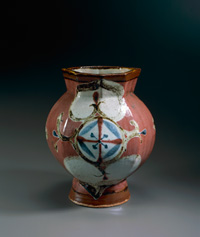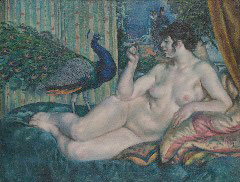Collection GalleryThe 1st Collection Gallery Exhibition 2017–2018 (162 works in all)
Collection Gallery
HOME > Collection Gallery > The 1st Collection Gallery Exhibition 2017–2018
The 1st Collection Gallery Exhibition 2017–2018 (162 works in all)
Exhibition Period
4. 19 (Wed.) – 6. 11 (Sun.), 2017
Overview
In parallel with the first collection gallery exhibition of this fiscal year, an exhibition entitled "Postwar German Posters for Films" is being held in our collection gallery. At the entrance, Saeki Yuzo's "Advertisements at a Back Street" is introduced based on the theme, "Street Scenes with Advertisements," which is followed by the paintings by Maurice Utrillo, who continued to focus on the streets of Montmartre, Paris and exerted a great influence on Saeki. In addition, we have on display a number of photographic works featuring large metropolis and suburban cityscapes with advertisements, and works by Aigasa Masayoshi and Alicia Framis, both of whom focus on the vast underground passages of the subway stations which are suitable for installing large-scale advertisements.
In the Japanese-style Painting Section, entitled "Modern Buddhist Painting," Buddhist paintings mainly from the Taisho and Showa periods have been placed on display. After the Meiji period, Japanese painters set up their respective Buddhist themes from far and wide without being restrained by conventional Buddhist iconography, and freely created their own works. Murakami Kagaku, who together with Tsuchida Bakusen played a major role in establishing Kokuga Sosaku Kyokai (the Society for National Paintings), dedicated himself to Buddhist paintings in his later years, creating numerous graceful images of Bodhisattva and Avalokitesvara. Kataoka Tamako, who is noted for her colorful portraits of eminent priests and nuns as represented by such works as "Buddhist Rite of Offering Flowers," "Buddhist Rite of Scattering Flowers" and "Buddhist Rite of Meditation," depicted Buddhist nuns who conduct Buddhist rituals in brilliant transparency. Furthermore, Domoto Insho's "Hariti" connotes the influence of triptychs depicting the Virgin Mary in the West. With western civilization surging toward Japan in the Modern Era, Japanese painters diligently strove to find various ways to transmit the teachings of Buddhism.

- MURAKAMI Kagaku, Avalokiteśvara, The Sacred Lotus, 1930
In the Craft Section, contemporary works of jewelry from the 1980s have been introduced from our collection in correlation with the special exhibition entitled "Mastery of an Art: Van Cleef & Arpels – High Jewelry and Japanese Crafts" being held on the 3rd floor. A trend known as "contemporary jewelry," which emphasized the concepts of the individual artist, began in the 1960s, in stark contrast to the world of fine jewelry, in which pieces are created from precious stones and metals, and the fashion trend of costume jewelry, which emphasizes less expensive materials such as semiprecious stones. One pioneer in this trend was Otto Künzli, who created works such as a cynical brooch called "The Swiss Gold," which was made from acrylic and cardboard. He concentrated on the fact that jewelry has a close relationship with the human body and functions as a catalyst signifying the relationship between "oneself and others" and "oneself and society." He eventually changed the concept of jewelry as being merely accessories and personal ornaments, and converted it into a metaphor which represents human existence and society, and created jewelry in extraordinary shapes made from paper, synthetic resin, cement and aluminum which often bewildered people in terms of how such pieces should be worn. The respective artists of this movement, however, have bequeathed strong messages for both people and society in each work.
Furthermore, selected works of Kawai Kanjiro from our Kawakatsu Collection have also been placed on display, following our previous collection gallery exhibition.

- KAWAI Kanjiro, Flat Vase of Lozenge Flower Design with Cinnabar Glaze, 1941
In the Western-style Painting Section, we have representative works acquired or donated after 2012 on display. In particular, Yasui Sotaro's "Peakcock and Woman" is considered a culmination of the works he created during his stay in Europe. This work clearly shows how fervently he studied both the classical paintings of Italy and Spain, and a new stream of expression as exemplified by the works of Cezanne.

- YASUI Sotaro, Peacock and Woman, 1914
We have a special feature entitled "Curatorial Studies 12: The 100th Anniversary of Duchamp's Fountain " in the section usually dedicated to prints or photography. This year marks the 100th anniversary of the first presentation of Marcel Duchamp's readymade, "Fountain." His sensational behavior – placing a porcelain urinal on its back, signing it and calling it "art" - questioned the meaning of art as a whole, and exerted an immeasurable influence on the art movements of the 20th century. The Collection Gallery Exhibitions of this fiscal year will focus on various interpretations and possibilities of deciphering the various meanings of Marcel Duchamp's "Fountain" through exhibits and lecture sessions in 5 consecutive series. We hope that our visitors will enjoy the first series, "Case 1: Marcel Duchamp sent a urinal to the 'First Annual Exhibition' in New York at the age of 29," as a basic response concerning what Marcel Duchamp's "Fountain" is all about.
Themes of Exhibition
- ・Curatorial Studies 12: The 100th Anniversary of Duchamp's Fountain
Case 1: Marcel Duchamp sent a urinal to the "First Annual Exhibition" in New York at the age of 29. - ・Street Scenes with Advertisements
- ・Modern Buddihist Painting
- ・<Contemporary Jewelry> in 1980s
- ・Selected Works of KAWAI Kanjiro from the KAWAKATSU Collection
- ・Western-style Painting from Recent Acquisition
- ・[Outside] Outdoor Sculptures


